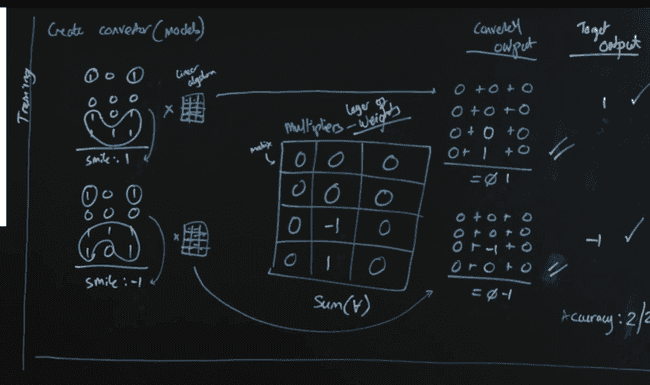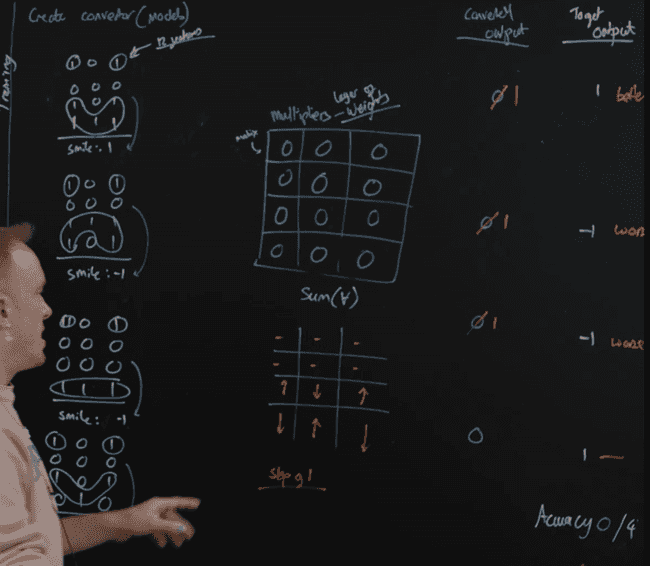AI/ML for Software Engineers
November 21, 2024https://frontendmasters.com/workshops/engineering-and-ai/
∀ = all
- population = all data
- sample = subset of data
- parameters - the rules
- features - the data pieces
- model - the algorithm
50 - why 50?
50^3 = 125000
greedy - get each stage correct, separately
Finding Features
- Data exploration (data scientist led)
- Smaller sample: 10-20%
- understanding the problem and data, watch for imbalances
- experiment with different model/approaches
- production model (ml engineer led)
- performance of training at scale
- end to end deployment
- ongoing performance
Sigmoid
σ sigmoid
signoid function converts all positive numbers to > 50% and all negative numbers to <50%
Neural Network
- weights: the values of the matrix
- matrix: multipliers
gradient descent
iindependent steps towards improved accuracy at once
0 0 0
0 0 0
1 -1 1
-1 1 -1
Results
loss = error rate
closer to 0 is -1 or not
closer to 100% is 1 or yes
Learning Materials
- deep learning (nerual network with lots of layers) - practical applications
- grokking series
- https://www.manning.com/books/grokking-algorithms
LLM
Natural Language Processing (NLP)
- text classification
- named entity recognition (NER)
- machine translation
- text transslation
- speech recognition
- text summarization
- question answering
tokeniization: splitting to smallest unit of semantic meaning
Embeddings
Embeddings express the model's understanding of an input. We don't (yet) know what these embeddings mean, but we can use them to find similarity and features.
Self-attention
- attention is the correlation of a given word to anohter word in a sentence
- self-attention allows a model to determine (and embed) the relevance to a given word of every other word in the sentence
Pre-training
- each pre-training epoch builds the model's 'understanding' of the dataset
- the model's predictive ability is contained wihtin it's parameters, which include a lossy compressed version of the training data
- pre-training produces a base model capable of generating that resemble its pre-training dataset
https://github.com/karpathy/nanoGPT
LLM Knowledge
- there is no intuitive way to discover what the model 'knows' (yet)
- models store probabilities, the pre-training objective is generalization
- fact generation is an unpredictable side effect
https://pair.withgoogle.com/explorables/fill-in-the-blank/
Fine Tuning
- using an LLM to follow instructions
- we produce alignment by fine-tuning the model to understand prompts and respond with a particular tone
Prompting
- programming in natural language
Mental Model
Imperfect
- pre-training and fine-tuning build the model's capacity to 'reason' (predict) through inplicit rules (long-term memory)
- prompting provides context to guide the model (short-term memory)
Better
- system 1 thinking: instictive, automatic, unconsicous, 2 * 3 =
- system 2 thinking: deliberate, effortful, consicous, 173 * 82 =
models are only capable of system 1 thinking
Strive For
- grounding
- consistency
- confidence
- interpretability
- alignment
- robustness
risks
- reliability
- social bias
- toxicity
- disinformation
- legal (fair use)
- cost / environmental impact / access
concerns
- testing
- version control
- latency
- modularity / composition
- monitoring
Prompting
https://blog.matt-rickard.com/p/a-list-of-leaked-system-prompts


